Cars & Bikes

The Invisible Woman: Unveiling Sue Storm's Powers, Evolution & Impact in the Fantastic Four
April 22, 2025 19 min read
"I know that, darling... I do. But I know other things now, too—things I’ve buried beneath smiles and force fields. Things I’ve been too afraid to name, too fragile to hold. Maybe it’s what they call growing up. Maybe it’s something worse."
The Psycho-Man didn’t just twist my emotions—he cracked the mirror I’d been too proud to look into. He didn’t just show me fear or rage—he forced me to feel. To see myself. Really see myself. Every scar. Every shadow. Every lie I told myself to keep the peace, to keep pretending.
We gained powers that day in the void—yes. But we lost something too. Something gentle. Something sacred. Innocence, maybe. That wide-eyed wonder that made the stars feel like home. And in its place came fire, came weight, came the truth.
I clung to the idea that I was still that girl—Reed’s girl. Johnny’s big sister. The team’s heart. The one who held everyone together. But that girl... she’s gone. She didn’t survive the Psycho-Man.
He didn’t just tamper with my emotions. He cracked my soul open and showed me the woman beneath the veil. The woman I’ve always been becoming.
There is no Invisible Girl anymore, Reed.
She’s gone.
She died screaming in the silence of her own repression.
What stands here now is something else—someone else. Stronger. Sharper. Not afraid of the shadows inside her anymore.
From this moment on—
I am the Invisible Woman.

Dr. Susan "Sue" Storm-Richards—a name etched into the annals of cosmic history. But long before the world knew her as the Invisible Woman, she was simply Sue Storm: a brilliant college student, chasing a life filled with science, love, and dreams that stretched as wide as the sky.
Everything changed the day she boarded a rocket not meant to fly.
The Marvel-1 was stolen. Risky. Reckless. But it was Reed Richards’ dream—her partner, her love—and Sue followed him into the unknown, alongside her younger brother Johnny Storm and their close friend Ben Grimm. They launched themselves into the stars... and came back changed.
Bathed in an onslaught of cosmic radiation, the four of them were torn from the ordinary. The universe didn’t ask permission—it simply rewrote their biology, reshaping their futures. For Sue, the transformation was as poetic as it was terrifying: her body turned invisible, and with it came the power to summon forcefields, to bend the unseen into weapons, shields, and cages of pure thought.
But her powers were only the beginning.
Together, the four of them became something more than human. They became the Fantastic Four—pioneers of the impossible. A team not built for battle, but for exploration. Not born from vengeance, but from curiosity and catastrophe. They charted the folds of time, wandered into alternate dimensions, stood between Earth and extinction time and again—all while shouldering the burden of being symbols in a world still learning to understand them.
And through it all, Sue evolved.
She was never just the “girl” on the team. Never just the emotional glue holding them together. She was the silent center of gravity. The one who bore the weight of leadership when Reed disappeared into his mind. The one who comforted a brother burning with youthful recklessness. The one who saw the soul in the Thing’s monstrous frame. She was grace under pressure, strength in silence, and power made flesh.
Early Echoes of Loss and Light
Before the stars ever touched her skin, before she became a living veil between worlds, Susan Storm’s life was marked by quieter tragedies. A girl from Long Island, Susan lost her mother to the cold cruelty of a car accident—a loss made sharper when her father, a doctor, failed to save her. That failure broke something in Franklin Storm. He drowned in drink and gambling, spiraled into darkness, and ultimately took a life in a desperate moment. That act landed him in prison, and left Susan and her younger brother Johnny adrift—children raised by their aunt in a boarding house full of strangers and shadows.
It was in that boarding house where Sue met Reed Richards, a man whose mind lived in galaxies not yet charted. He was a boarder with cosmic dreams and equations for lullabies, and she, still a teenager, fell for him like gravity. Years later, she followed him to California, a flickering dream of showbiz half-formed in her mind, but Reed’s light was too strong—she was drawn into his orbit.
And so she boarded the Marvel-1. Alongside Reed, her fiery brother Johnny, and the ever-loyal Ben Grimm, Susan Storm pierced the sky and plunged into the unknown. But the price of touching the infinite is always steep. The cosmic rays that bathed them in power also burned away something else—innocence, perhaps. What returned to Earth wasn’t the same Susan Storm. She was invisible now. But not just to the eye.
Holding the Center

In the early days of the Fantastic Four, Sue was often the quiet strength behind the chaos. Reed buried himself in calculations, Ben wrestled with self-loathing, and Johnny chased the flame of adolescence. And Sue? She held the team together, not with brute force, but with empathy. Her powers—limited at first—felt secondary to her emotional gravity. Villains like Galactus and Doctor Doom could be fended off with tech and tenacity. But only Sue could stop the Fantastic Four from falling apart.
That strength came with its own burdens. When Namor, the regal sea king, offered her love and escape, she faltered. Not because she didn’t love Reed—but because she wondered who she had become. A woman trapped between worlds. A girl playing at being whole.
But Sue didn’t just survive. She evolved. Her forcefields became shields, weapons, tools. She could bend the very air around her to her will. She was no longer just hiding—she was shaping reality.
A Mother and a Warrior
Marriage to Reed brought a new kind of chaos—intimate, domestic, profound. Sue’s pregnancy with Franklin, their son, pushed her to the edge of life and death. The Negative Zone, Annihilus, desperate gambles for survival—it was heroism in a different light. And when Franklin’s terrifying powers bloomed too early, threatening to tear reality apart, it was Reed who made the impossible choice to suppress their son’s mind. But it was Sue who broke. She left, taking Franklin with her—not because she stopped loving Reed, but because the weight had become too much.
Yet the bonds always brought her back. Another child, Valeria, conceived on a rare quiet retreat, died before birth—or so they believed. That loss haunted her. Years later, in one of the most cosmic turns of fate, Franklin revealed he’d saved Valeria in secret, raising her in an alternate future. She returned not as a ghost, but as a girl. A daughter reborn.
Becoming Malice, Becoming Woman

The mask cracked again when the Psycho-Man twisted her soul. He didn’t just manipulate Sue—he unleashed her. The fury, the pain, the resentment long buried beneath smiles and sacrifice. She became Malice, a mirror of herself without compassion. And it terrified her. When Reed helped her come back, Sue shed the last remnants of her old identity.
The Invisible Girl was gone.
She was now the Invisible Woman.
That transformation wasn’t just about powers—it was about self-acceptance. About owning the anger and the strength. She learned to wield “Force Objects,” creative, kinetic manifestations of her will. But the shadow of Malice never fully left. She knew now that the darkness wasn’t something to be vanquished—it was something to live with.
Where It All Began
Susan Storm grew up on Long Island. Her early life was marked by loss—her mother died in a car crash, and her father, Dr. Franklin Storm, never recovered. His grief led him down a dark path that ended with him accidentally taking a man’s life. After that, Sue and her younger brother Johnny were raised by their aunt.
During that time, a young Reed Richards rented a room in their boarding house. He was older, already deep into his studies in science and engineering. Sue, still in her teens, was fascinated by him and eventually fell in love. Years later, she followed him to California, still chasing a possible career in acting, but her connection with Reed took center stage.
That connection led her to join Reed, Johnny, and Ben Grimm on the fateful space mission that changed everything. The team was hit with cosmic rays, and Sue gained the power to turn invisible.
But that was just the beginning.
Finding Her Place in the Team
Early on, Sue was called the Invisible Girl, and for a while, her contributions were downplayed. She didn’t have the raw power of Ben or Johnny, or Reed’s brainpower. But what Sue lacked in spectacle, she made up for in emotional intelligence and stability. She kept the Fantastic Four from falling apart during some of their most chaotic early years.
As her powers evolved, Sue became far more than just the one who turned invisible. She learned to generate forcefields—initially defensive, but over time they became powerful tools. She could fly, create weapons, traps, even complex constructs with them.
Eventually, her powers made her arguably the strongest member of the team. But she wasn’t just a powerhouse—she was their emotional center too.
Marriage, Motherhood, and Cosmic Problems
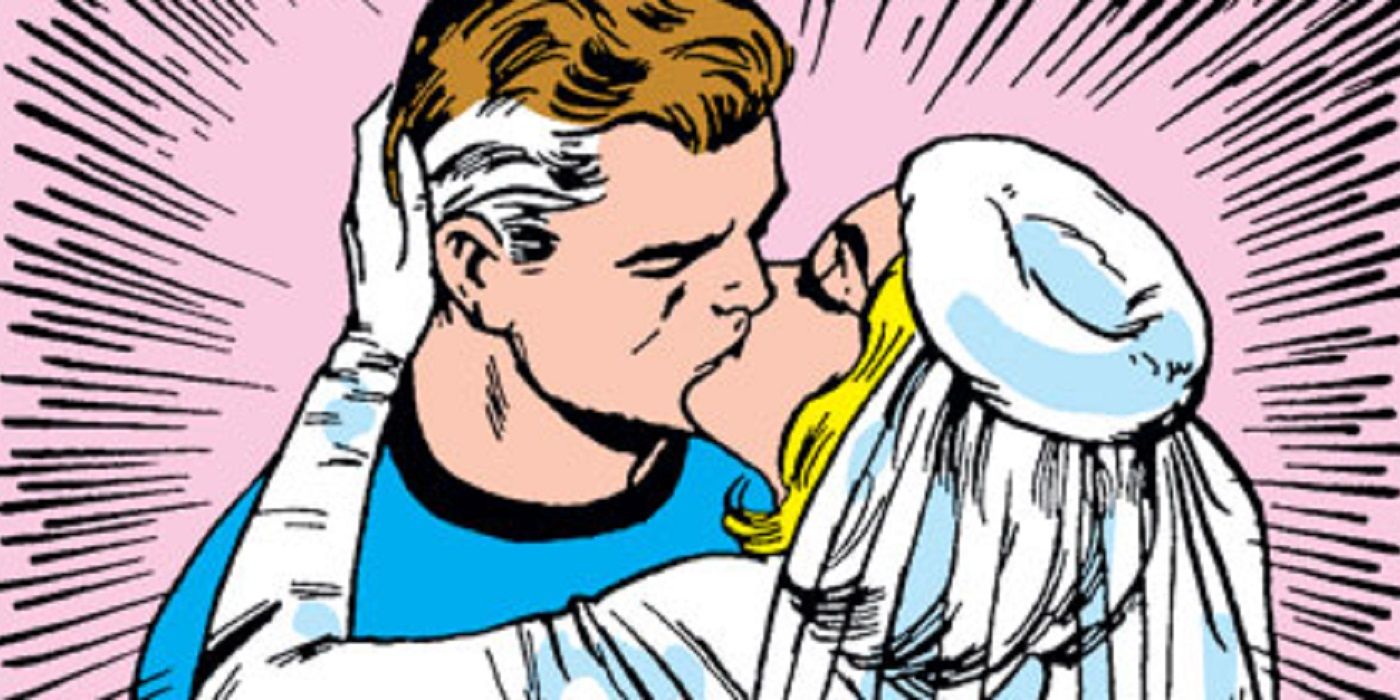
Sue married Reed, but the relationship wasn’t always easy. Reed was often emotionally distant, caught up in his research. She loved him, but sometimes questioned whether she was truly his equal, or just another variable in his calculations. At one point, Namor the Sub-Mariner even tried to win her over. Sue didn’t leave Reed, but the temptation showed that she was more than just someone’s wife—she was a person with choices, agency, and desires.
Her life got even more complicated when she became a mother. Sue’s first pregnancy nearly killed her. She gave birth to Franklin Richards, a mutant with reality-warping powers that no one could fully control. At one point, Reed made the tough call to shut Franklin’s mind down temporarily to prevent a global catastrophe. Sue didn’t take it well. She took Franklin and left Reed for a while—not because she stopped loving him, but because she needed space after a decision that big was made without her.
Later, they had a daughter, Valeria, under unusual circumstances. She was initially stillborn, but Franklin saved her using his powers and placed her in an alternate future. She returned years later, alive and raised by an alternate version of Doctor Doom. Yeah, it got weird.
The Malice Era
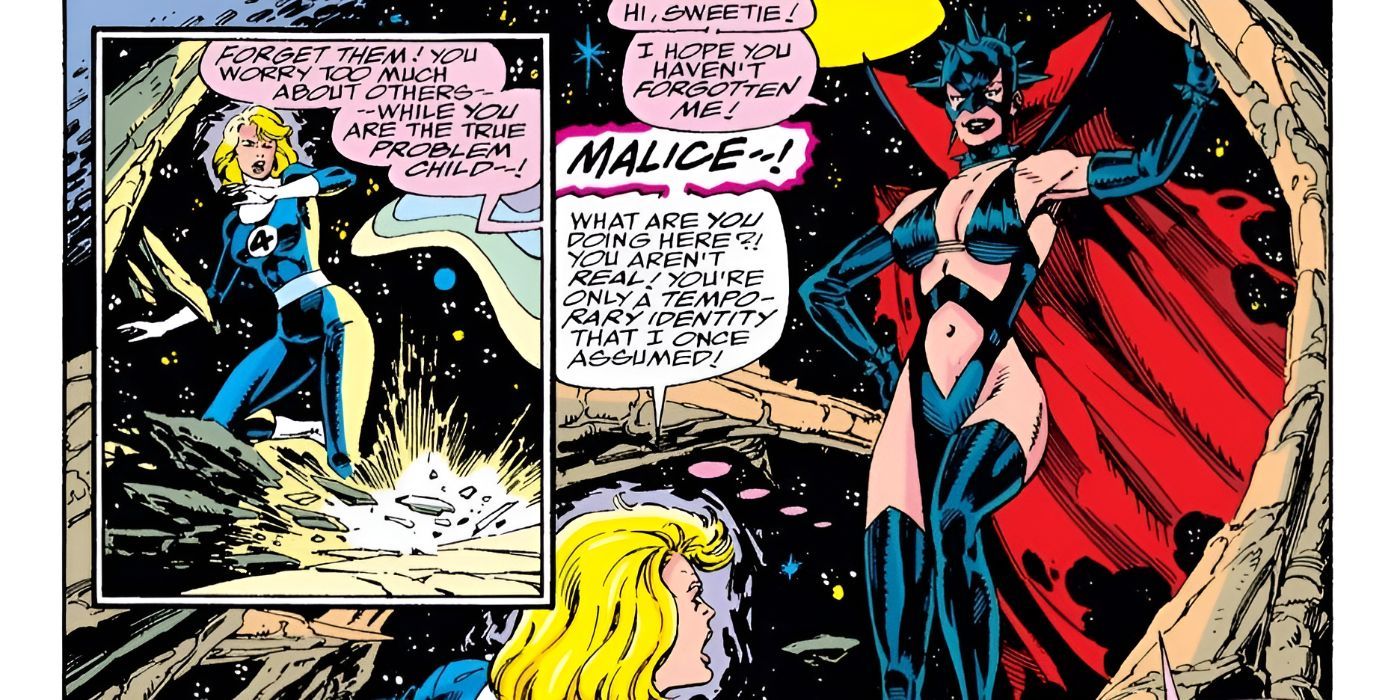
One of Sue’s most pivotal moments came when the Psycho-Man manipulated her emotions. Under his influence, she became Malice—a cruel, sadistic version of herself who used her powers aggressively and without mercy.
She eventually snapped out of it, but the experience stuck with her. It changed how she viewed herself. From that point on, she stopped calling herself the Invisible Girl. She embraced the title of Invisible Woman—because she had been through too much to keep playing the passive role.
She began using her powers with a level of confidence and creativity that made her a true tactical threat. She could drop forcefields inside someone’s lungs, cut through titanium, or block out an entire explosion. She was no longer just support—she was the difference between victory and defeat.
The Leader of the Fantastic Four
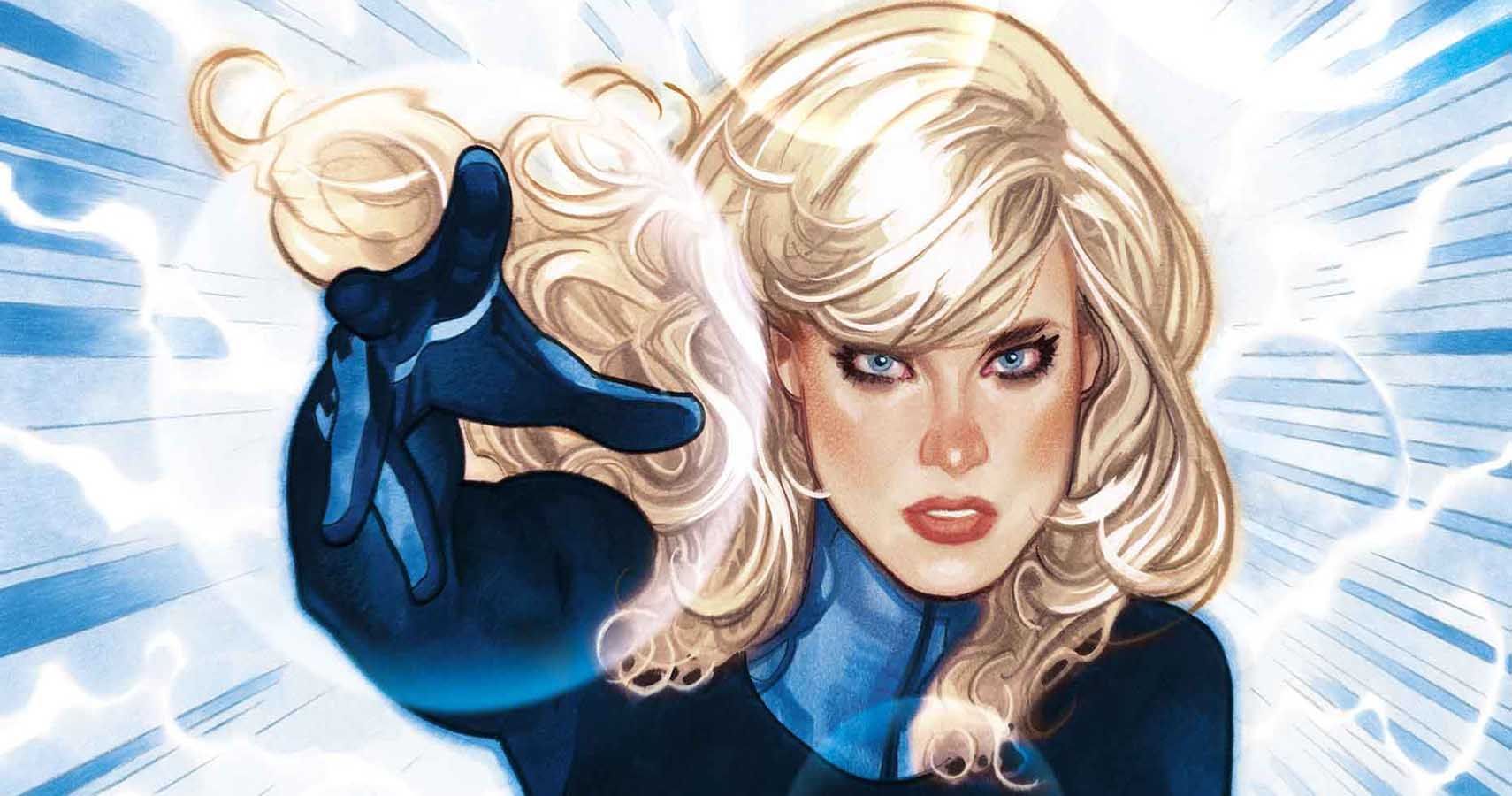
When Reed went missing, Sue took over as leader of the Fantastic Four. She didn’t just fill his shoes—she made decisions that kept the team together during one of its most uncertain periods. Even when Victor Von Doom offered her power or peace in exchange for affection or alliance, she never gave in.
She’s walked through Hell to rescue her son, literally. She’s faced gods, cosmic entities, and universe-ending threats. She’s balanced being a mother, wife, and superhero while dealing with losses that would break most people.
The Real Core of the Fantastic Four
Sue has always been more than the team’s heart—she’s often the reason they’re still standing. Reed might lead with logic, Ben with loyalty, and Johnny with passion, but Sue leads with balance. She sees the bigger picture. She holds it all together.
Her powers aren’t flashy in the traditional superhero sense, but her control over them makes her incredibly dangerous when she needs to be. She doesn’t have the ego that usually comes with being that powerful. She just gets the job done.
In many ways, being “invisible” was never about her powers—it was about being underestimated, overlooked, and underappreciated. But over the years, Sue Storm has made it clear: she’s not invisible anymore.
CIVIL WAR

The lines were drawn, and the Fantastic Four were no longer one. Reed stood behind the Superhuman Registration Act—his belief in logic and order driving him there. But Sue couldn’t stomach it. Not after watching a clone of Thor kill Goliath like that. She and Johnny slipped into the resistance, helped by Nick Fury, who gave them fake identities as a married couple—an awkward cover neither of them found amusing.
At the final battle, when Taskmaster pulled the trigger, Reed didn’t hesitate—he took the bullet for her. Sue didn’t hold back either. Her force fields turned defensive into devastating as she slammed Taskmaster into the ground. The war ended. The city was in ruins. But she helped rebuild. She and Reed took a break from the team. Not to run, but to find each other again.
BACK TO ACTION / WORLD WAR HULK / TIME TRAVEL ENTANGLEMENTS
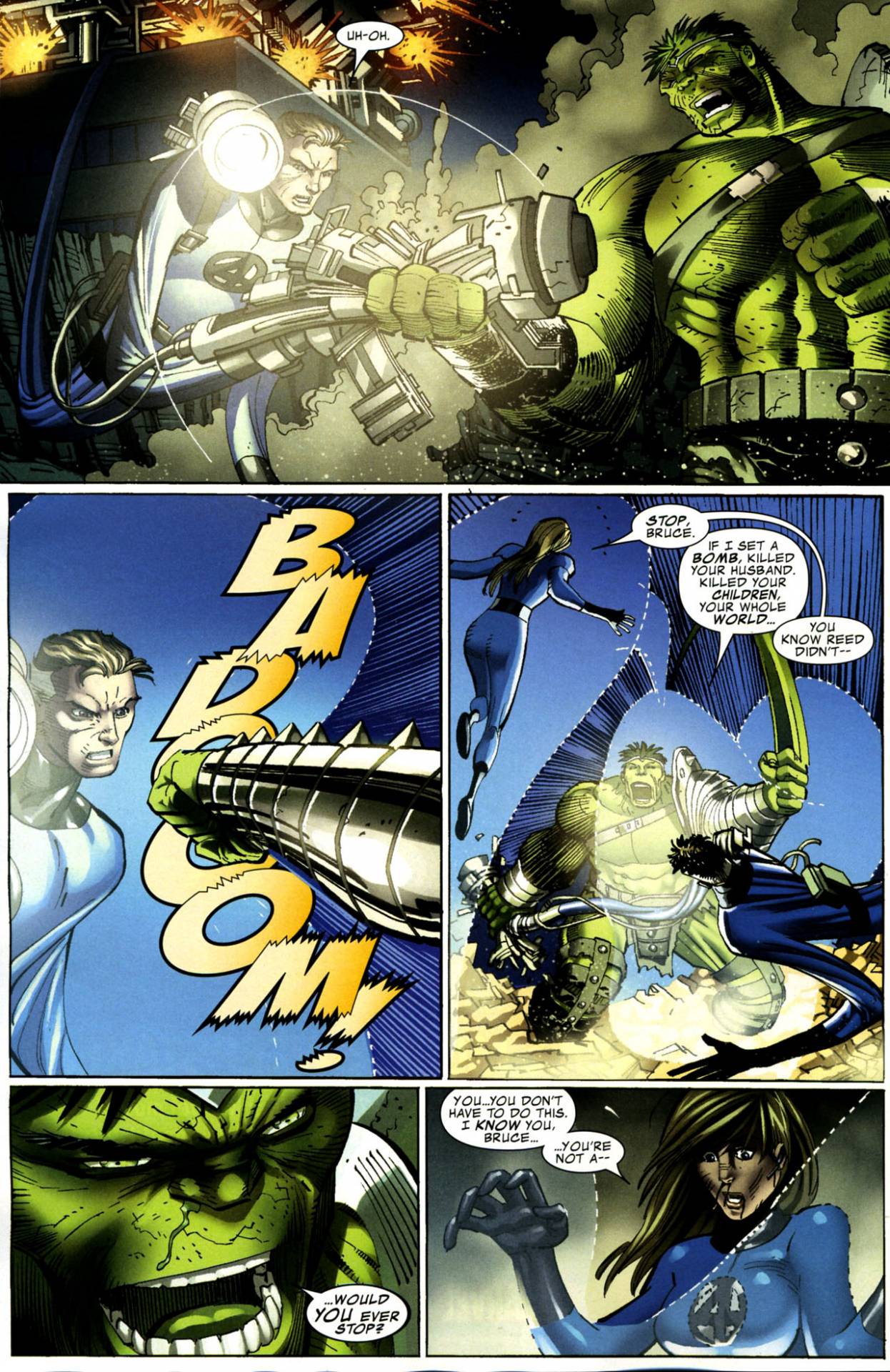
Peace didn’t last. The Frightful Four dragged them back in, and during World War Hulk, Sue tried to shield Reed again—but even her power couldn’t stop the Hulk. Then came the new nanny, Tabitha Deneuve, and a strange team called the New Defenders. Johnny got involved with one of them. It ended badly. He was kidnapped—along with Doom and Galactus. Turns out Tabitha wasn’t just anyone—she was Susan Richards from 500 years in the future.
Her future self had built a machine to save the next Earth. It worked—but not without cost. Doom killed her. And even though she wasn’t this Sue, they mourned her like she was. Because in some way, she was.
SECRET INVASION
In Vancouver, during a routine lecture, Sue was ambushed. A Skrull used her own powers against her—pressure to the skull, then blackness. Meanwhile, back home, another Skrull impersonated her and trapped her family in the Negative Zone. That imposter was Lyja—Johnny’s ex-wife. Messy history repeating itself. The real Sue was later found alive. Beaten, betrayed—but breathing.
THE BRIDGE
Reed built something called “The Bridge.” A machine to peer into alternate worlds—obsessed with figuring out why their Civil War even happened. While Reed chased ghosts through the multiverse, Sue, Johnny, and Ben fought off HAMMER agents and got yanked into a bizarre world where another Civil War was tearing through the Hyborian Age. When they returned, Sue begged Reed to destroy the machine. He said he did. He didn’t.
THREE / DEATH OF JOHNNY STORM

Serving as a diplomat between Atlantis factions, Sue was pulled into royal politics—and ended up regent of Old Atlantis. But the crown felt heavy. Then the news hit: Johnny was dead. Gone, fighting off the Annihilation Wave. Her brother. Her heart. She was shattered.
FUTURE FOUNDATION
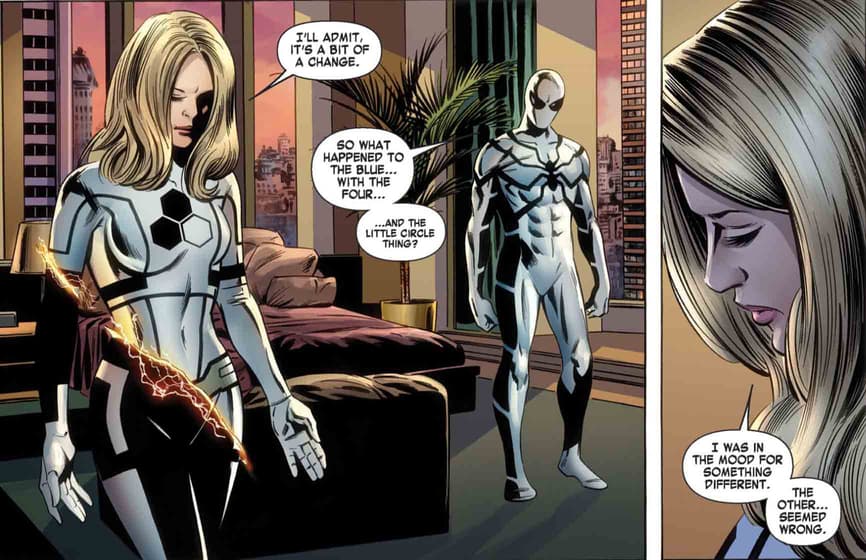
They renamed themselves—the Future Foundation. A tribute. A mission. Spider-Man stepped in where Johnny once stood. Then came the Kree, the Negative Zone, the cults, and a living Johnny Storm returned from death, commanding the Annihilation Wave like a king of monsters. Reed summoned Galactus. Franklin, now a cosmic force, healed the Devourer and helped save the universe. The family rebuilt—again.
FALL OF THE FANTASTIC FOUR
Then things fell apart.
Johnny lost his powers. Ben got arrested. Their kids were taken by S.H.I.E.L.D. Reed started unraveling. Sue—angry, hurt—started changing. They weren’t just losing battles. They were losing each other. The villain? The Quiet Man. Behind it all. Reed went missing. Johnny spiraled. But when the family pulled together to fight back—when the team became them again—they endured.
SECRET WARS
When the universe faced its final collapse, Reed, Sue, and their children tried to escape in a life raft. The hull was breached. They died—at least as far as the world knew. What really happened? They woke in Battleworld, ruled by a god-king Doom. Reed fought him, won, and inherited the power of creation itself.
He used it to bring Sue and the kids back. To rebuild everything. The multiverse. The Future Foundation. Hope.
FATE OF THE FOUR
But even rebuilding reality has its limits. Franklin’s powers began fading. Then came the Griever—a cosmic executioner who destroyed hundreds of universes they’d created. Reed pulled a last-ditch move—summoning everyone who had ever been part of the team. They won. But the message was clear: it was time to go home.
Sue, Reed, Franklin, and Valeria returned. Only a few months had passed on Earth, but they had been gone for years.
POST-RETURN & ESPIONAGE MISSIONS
Back on Earth, they resumed their mission. They reached the planet Spyre, only to discover the inhabitants had known they were coming all along—and had tried to destroy them years ago.
Later, when her old espionage partner was captured, Sue went solo. Through Madripoor, Rome, and crashing planes, she did what needed doing—balancing her secret-agent past with her superhero present. In the end, she made a choice that cost someone their life. It hurt. But she didn’t flinch.
FANTASTIC FOUR NO MORE
After Reed teleported the Baxter Building into the future to stop an alien invasion, their kids—trapped inside—were gone for a year. Sue supported him. But the rest of the team was furious. Public trust crumbled. The Fantastic Four disbanded.
Sue and Reed tried to reconnect with Ben and Alicia—only to stumble into a town run by Doombots, built in memory of a kind woman who once helped a young Doom. That memory was all that remained. They buried her. Gave peace to a town of machines. And moved on.
FANTASTIC FARMHOUSE & A FAMILY REUNITED
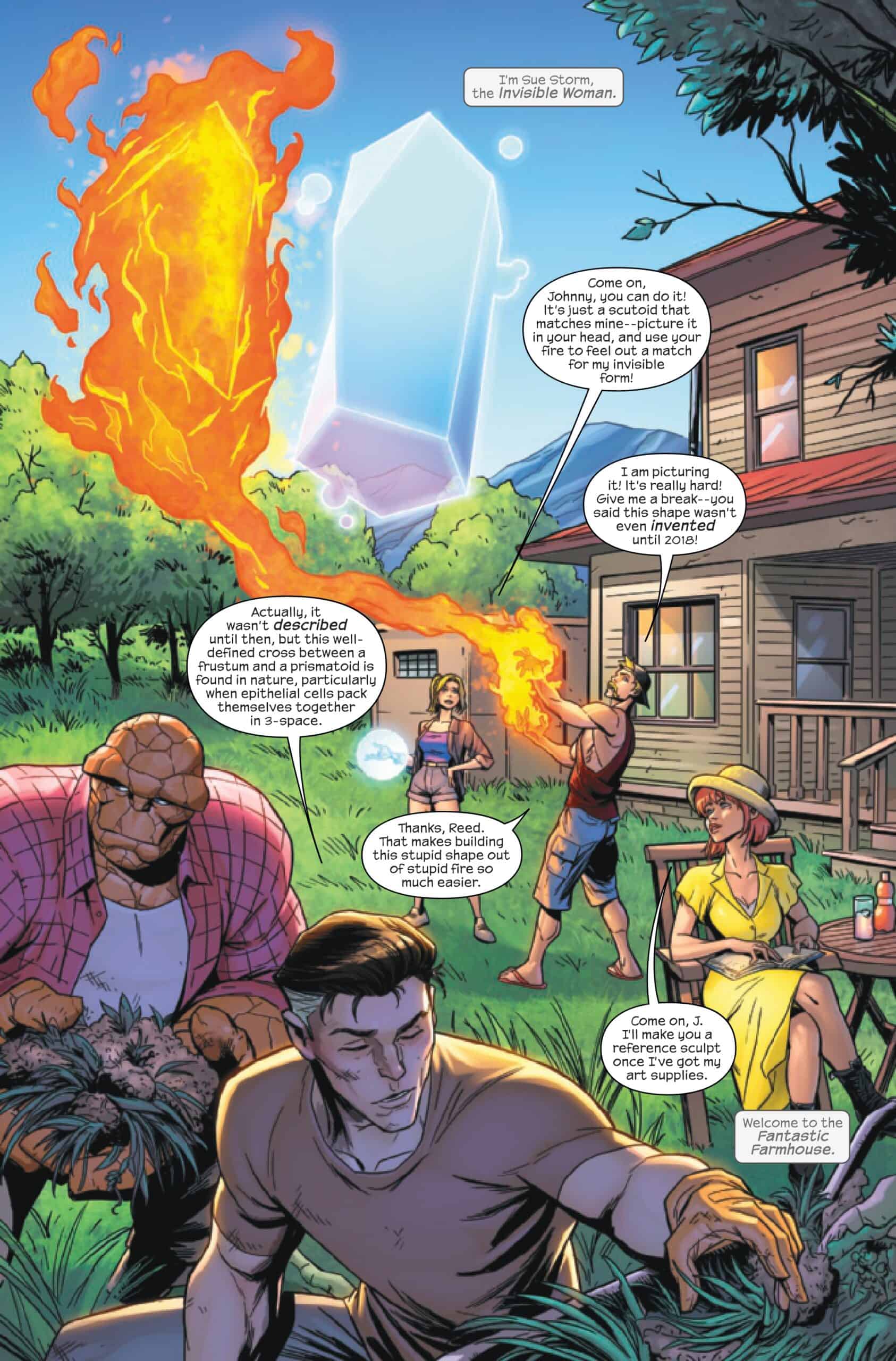
Eventually, the Four reformed. Not in a high-tech tower, but a simple farmhouse in Arizona. They called it the Fantastic Farmhouse. A quiet name. A fresh start. And when the Baxter Building and the children finally returned—so did their joy.
For now, they’re together. After everything—wars, invasions, multiversal death and rebirth—they’re still standing.
And Sue Storm? She’s still the invisible shield at the heart of it all.
The Invisible Woman: The Unseen Force Behind the Storm

Sue Storm was born in starlight—bathed in the silent fury of cosmic rays, rewritten at a cellular level by the mysteries of Hyperspace. But her real metamorphosis? It was psychological. She didn't just gain power; she became power. And still, she chose subtlety over spectacle.
Power Grid: The Quiet Infinity

Sue’s abilities, at their peak, border on the godlike—creation and destruction held within a single breath. Hyperstorm once said she’s barely scratched the surface of what she could become. That she’s a sleeping giant in the Marvel cosmos—one whose limits don’t lie in physics, but in her own compassion.
Invisibility / Light Manipulation

She doesn’t disappear. She decides not to be seen.
Sue manipulates cosmic energy in a way that light bends around her. She can vanish herself, her family, even cities—and once, an entire planet. Her gift isn’t just absence. It’s precision. She can turn a retina transparent to blind someone, darken muscle tissue to simulate burns, or peel away layers of visibility like a surgeon revealing the truth behind the curtain of light.
She once starved parasitic bacteria of sunlight across multiple states—a mercy that became an accidental extinction. That’s the scale she dances on. Light, bent to her will. Truth, hidden or revealed at her choosing.
Electromagnetic Spectrum Manipulation
She’s not just invisible. She owns the entire EM spectrum. She can hide from machines, scramble illusions, alter colors, and dodge detection with surgical elegance. Her power doesn’t just silence sight—it redefines perception itself. Her enemies don’t realize they’ve lost until they’re standing in the middle of nothing.
Psionic Hyperspace Force Fields

Where others build walls, Sue paints with force.
Her fields are drawn from Hyperspace—an invisible architecture only her mind can fully grasp. Domes, needles, labyrinths of solid nothingness. She can cradle a heartbeat or crack the sky. At their smallest, her fields can thread arteries or press a nerve like a whisper. At their largest, they’ve protected her family through black holes and against beings like Galactus.
She once shaped a force dome a mile wide and an inch thick, defying scale with mental focus alone. The field isn't matter. It can’t be moved, phased through, or disrupted by molecular tampering. It isn’t there—until it’s everything.
And only she sees it, through eyes evolved to track cosmic ray reflections. Her gaze maps what others can't even comprehend.
Flight and Constructs

With a flick of thought, she can levitate—by riding her own constructs like windborne shields. She shapes stairs mid-air, builds invisible paths, creates weapons of pure psionic tension. Each structure moves with the grace of intention. Strength sculpted by empathy.
Force Interactions and Deflection
Soundproof, airtight, magic-resistant, telepathy-nullifying—her shields do more than defend. They deny. Jean Grey couldn’t lift a feather around her. Psi-Lord couldn’t read her thoughts. Red Ghost lost his intangibility just by brushing her field. Even gravity itself loses meaning when Sue says so.
And when she wants silence? The field absorbs sound like a void. High-frequency attacks, seismic pulses, even sunburns—muted by the veil she weaves.
Psychic Tracking and Energy Snaring
Sue doesn’t just protect. She hunts. Her energy field reacts to other psionic signatures, sniffing out their source. She can trace, cancel, even redirect psychic or magical forces—turning them inward like a karmic loop. She once used her powers to fold light into a glowing torch, made from nothing but trapped ambiance.
That’s her in a line: clarity conjured from unseen chaos.
Internal Offence: The Gentle Nightmare
She could end most fights before they start. She doesn’t, but the threat hums beneath her every breath.
She can crush lungs with force shaped like breath. Create blood clots at a distance. Apply pressure to brainstems. Inject air bubbles into hearts. She could cause strokes, suffocate enemies silently, induce paralysis with a smile. She once threatened to give the Wizard a coronary embolism without ever laying a hand.
But she rarely chooses pain. That’s her real superpower.
Kinetic Control and Shockwaves
Her fields can take the force of Class 100 impacts and dissipate them like silk. She can weaponize inertia, turn her fields into shockwaves that flatten titans. With practice, she’s learned to sculpt her force to absorb energy rather than transfer it—making a 60 mph impact feel like falling into a cloud.
The Singularity Within
There’s poetry in the way she can collapse her field into a singularity—gathering force like gravity, folding it inward until even light flees. She holds the math of catastrophe in her hands, and still chooses tenderness.
Cosmic Ray Sight and Radar Sense
Even blinded, she sees. Her retinas are tuned to interpret cosmic radiation, granting her sight where others go blind. She can detect bodies, motion, even emotion—through vibrations and low-level force emissions. It’s radar, but also something more… something spiritual.
Conclusion: More Than Power
Sue Storm isn’t just a force of nature. She’s the calm inside it. A mother, a leader, a moral compass wrapped in refracted starlight. She hides not because she’s afraid—but because she knows the weight of visibility. The burden of power wielded carelessly.
She sees everything, even when she isn’t seen.
And when she is seen… the whole world pays attention.
Abilities – The Quiet Grace of Mastery
Beneath the façade of a suburban mother or Manhattan adventurer, Sue Storm was always a performer. Not in the hollow, spotlight-hungry way—but in the subtle command of presence. She'd once dabbled in acting, letting other lives momentarily live behind her eyes. There, she learned how to project more than invisibility—she learned how to feel seen.
Before cosmic rays or force fields, Sue was a champion sailor, carving through the ocean as if she and the tide were one. By her teens, she had tasted the hush of the sea and the roar of the wind, both on her terms. In a life surrounded by elements and gods, water was the first one she ever bent to her will.
But she didn’t stop with grace—she trained her fists too. Judo under Reed’s careful instruction taught her leverage. Iron Fist taught her precision. And then came bojutsu—where Sue, ever the innovator, conjured her own invisible staff. Her style was as quiet as it was lethal, a ballet of discipline wrapped in pure force. When she fought, she fought like someone with something to protect.
Weaknesses – The Cost of Power
Power, for Sue, was a double-edged whisper. Her gifts are tethered to her mind—one slip in focus, one moment of doubt, and her constructs vanish like smoke. If her force fields shatter, the feedback surges into her like a physical betrayal. Her strength is her mind—and its every fracture costs her.
Sound—ironically—can seep in. Songbird once turned melody into a weapon, slipping through Sue’s field and knocking her down with a song. Not everything loud can be silenced by silence.
But perhaps her greatest vulnerability is familial—the invisible tether between the Fantastic Four. They are fragments of the same cosmic rebirth. Separated across realities too long, their powers begin to dim. They are strongest together, weakened by cosmic solitude.
Paraphernalia – Tools of a Cosmic Matriarch
Sue doesn’t wield weapons in the traditional sense. Her suit, sewn from unstable molecules, adapts to her—turning invisible when she does. It hums with transceivers and sensors, keeping her connected to her team even when the world forgets she’s there.
On her hand, a glove with a keypad and screen—a quiet commander’s tool, accessing Reed’s data webs and the health pulses of her family.
She carries the Fantasti-Flare, a flare gun that burns a bright, sky-etched “4.” To civilians, it’s a symbol. To the team, it’s a call back to home.
Her Universal Translator is more than tech—it’s her bridge between civilizations. She speaks the tongues of galaxies with calm clarity.
And then there’s the Micro-Galaxy Ring—a miniature cosmos gifted by Reed, holding seventy-four inhabited worlds. A wedding band of stars. A universe wrapped around her finger.
Transportation – Movement Beyond the Mundane
Sue has traveled more ways than most people dream. Through skies in the Fantasti-Car Mk II, beneath oceans in the U-Car, through realms on Skrull saucers and Avengers Quinjets. She's flown in the "flying bathtub" and walked on the skin of dimensions. If there's a way to move, Sue’s ridden it. But more often than not, she carries others forward.
Notes – Shadows and Scars
In one fractured future, Ahab turned her into a Hound—trained to hunt her own. But even that darkness couldn’t consume her.
And in the rarest of moments, Sue has done the unthinkable—pierced the armor of a Celestial. Not even gods are safe from her will.
Trivia – Echoes of the Human
Jack Kirby, the father of many myths, named her after his daughter. In that gesture, Sue became more than a character—she became legacy.
She once appeared on a Marvel Value Stamp—Number 33. A small square of ink that held a universe.
It’s since been retconned that she wasn’t a model in her youth. Instead, she earned a doctorate—rewriting her own myth to escape the confines of 1960s archetypes. She isn’t the girl in distress anymore. She never was.
Each member of the Fantastic Four represents an element—Sue’s is air. Invisible. Essential. Often unnoticed. Always present.
Her hair has changed often—mirroring Janet Van Dyne’s fashion-forward flair—but it always reflected her state of mind.
And though she rarely spoke of it, Sue was devout. Faith was her quiet comfort. Catholic by implication, perhaps—but more than that, spiritual in solitude.
Her favorite film? West Side Story. A tale of love, division, and impossible hope. Maybe she saw herself in Maria, watching a world shift and shatter, and still finding the strength to sing.
Sue Storm, the Invisible Woman, is not just a force field or a silent protector—she is the quiet storm that shapes worlds, the unspoken backbone of the Fantastic Four. In a life where invisibility is both a gift and a curse, she remains a constant: an ever-present force in a family bound by love, sacrifice, and the cosmic balance of power.
Her journey is one of transformation, from the sheltered girl beneath the shadow of her brother’s recklessness to the fierce matriarch of a team that has fought gods and monsters alike. She has crafted not only worlds with her mind but also her own identity, one that refuses to be defined by the limits imposed by others.
Invisible, yes. But never insignificant. Sue Storm is, in every sense, the invisible thread that holds everything together—whether that thread is in the air, through the galaxy, or within the hearts of her family.
As we continue to watch her evolve across the pages of Marvel Comics, we are reminded: strength is not always seen, but it is always felt.
Subscribe
Sign up to get the latest on sales, new releases and more …
